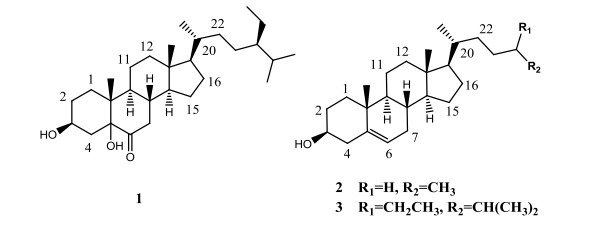-
[1]
Liao, Z. Y.; Wei, W. Studies on volatile constituents and their anti-tumor activities from the peel and shell of Podocarpus nagi fruits. Her. Med. 2015, 34, 609–612.
-
[2]
State administration of traditional Chinese medicine editorial board of Zhong Hua Ben Cao. Zhong Hua Ben Cao. Shanghai Scientific & Technical Publishers, China 1999, p813.
-
[3]
Dai, B. Chinese Modern Yao Medicine. Nanning: Guangxi Science and Technology Publishers, China 2009, p257.
-
[4]
Yang, Y.; Yong, J. P.; Lu, C. Z. Chemical and biological progress of Podocarpus nagi. Biomed. Res. Rev. 2019, 2, 1–5.
-
[5]
Zheng, Y. D.; Bai, G.; Tang, C. P.; Ke, C. Q.; Yao, S.; Tong, L. J.; Feng, F.; Li, Y.; Ding, J.; Xie, H.; Ye, Y. 7α, 8α-Epoxynagilactones and their glucosides from the twigs of Podocarpus nagi: isolation, structures, and cytotoxic activities. Fitoterapia 2018, 125, 174–183.
doi: 10.1016/j.fitote.2018.01.007
-
[6]
Wang, Q. X.; Yang, Z. F.; Peng, W.; Zhang, Y. K.; Chen, Y. G. Study on the constituents of Podocarpus nagi. J. Hainan Normal Univ. (Nat. Sci. ) 2018, 31, 1–5.
-
[7]
Feng, Z. L.; Zhang, T.; Liu, J. X.; Chen, X. P.; Gan, L. S.; Ye, Y.; Lin, L. G. New podolactones from the seeds of Podocarpus nagi and their anti-inflammatory effect. J. Nat. Med. 2018, 72, 882–889.
doi: 10.1007/s11418-018-1219-5
-
[8]
Yong, J. P.; Lu, C. Z.; Zhang, S. B. Preparation method and use of Podocarpus nagi kernel oil. New Australian Innovation Patent. Application Number: 2020100726.
-
[9]
Kovganko, N. V.; Kashkan, Z. N. Synthesis of natural phytosteroids of the 6-ketostigmastane series and compounds related to them. Chem. Nat. Compd. 1990, 26, 656–660.
doi: 10.1007/BF00630075
-
[10]
Subash-Babu, S.; Ignacimuthu, S.; Agastian, P.; Varghese, B. Partial regeneration of β-cells in the islets of Langerhans by Nymphayol a sterol isolated from Nymphaea stellata (Willd.) flowers. Bioorg. Med. Chem. 2009, 17, 2864–2870.
doi: 10.1016/j.bmc.2009.02.021
-
[11]
Klingberg, S.; Andersson, H.; Mulligan, A.; Bhaniani, A.; Welch, A.; Bingham, S.; Khaw, K. T.; Andersson, S.; Ellegård, L. Food sources of plant sterols in the EPIC Norfolk population. Eur. J. Clin. Nutr. 2008, 62, 695–703.
doi: 10.1038/sj.ejcn.1602765
-
[12]
Kovganko, N. V.; Kashkan, Z. N.; Borisov, E. V.; Batura, E. V. 13C NMR spectra of β-sitosterol derivatives with oxidized rings A and B. Chem. Nat. Compd. 1999, 5, 646–649.
-
[13]
Kovganko, N. V.; Kashkan, Z. N.; Borisov, E. V. 13C NMR spectra of functionally substituted 3β-chloroderivatives of cholesterol and β-sitosterol. Chem. Nat. Compd. 2000, 36, 595–598.
doi: 10.1023/A:1017519926605
-
[14]
Wu, X. Y.; Chao, Z. M.; Wang, C.; Sun, W.; Zhang, G. F. Extraction and crystal structure of β-sitosterol. Chin. J. Struct. Chem. 2014, 33, 801–806.
-
[15]
Li, W. H.; Chang, S. T.; Chang, S. C.; Chang, H. T. Isolation of antibacterial diterpenoids from Cryptomeria japonica bark. Nat. Prod. Res. 2008, 22, 1085–1093.
doi: 10.1080/14786410802267510
-
[16]
Tasyriq, M.; Najmuldeen, I. A.; In, L. L. A.; Mohamad, K.; Awang, K.; Hasima, N.; Olajide, O. A. 7α-Hydroxy-β-sitosterol from Chisocheton tomentosus induces apoptosis via dysregulation of cellular Bax/Bcl-2 ratio and cell cycle arrest by downregulating ERK1/2 activation. Evid. -based Complement Altern. Med. 2012, 2012.
-
[17]
Wang, L.; Yang, Y. J.; Chen, S. H.; Ge, X. R.; Xu, C. J.; Gui, S. Q. Effects of beta-sitosterol on microtubular systems in cervical cancer cells. Natl. Med. J. Chin. 2006, 86, 2771–2775.
-
[18]
Tominaga, H.; Ishiyama, M.; Ohseto, F.; Sasamoto, K.; Hamamoto, T.; Suzuki, K.; Watanabe, M. A water-soluble tetrazolium salt useful for colorimetric cell viability assay. Anal. Commun. 1999, 36, 47–50.
-
[19]
Sheldrick, G. M. SHELXL-2014/7, Program for Refinement of Crystal Structures. Institute for Inorganic Chemistry. University of Gottingen: Gottingen, Germany 2014.

 Login In
Login In







 DownLoad:
DownLoad:

